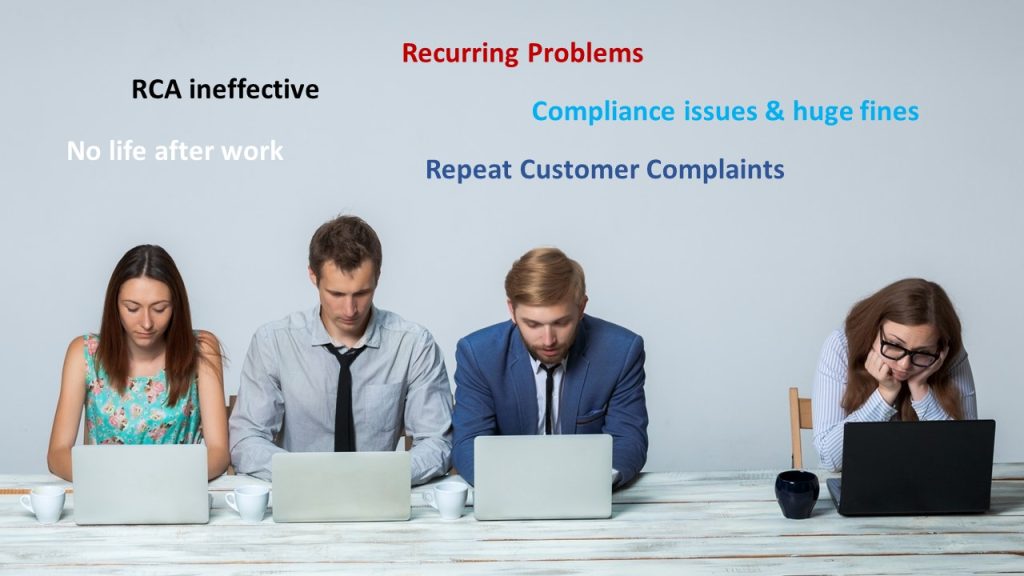3L 5Why Analysis
3L 5Why Analysis
3L 5Why Analysis is synonymous with Root Cause Analysis nowadays with most organizations having knowledge and know-how to perform 5 Why analysis. Most leaders encourage their leaders to use 5 why analysis to identify the root cause. That’s the good news!

Now the bad news 🙁 Most of the 5 Why analysis are incomplete and provide only tactical means to the current situation. They hardly look at underlying system level causes. If you don’t agree, list down all those problems in your organization that have been occurring for more than 5 years now, manifesting itself in some form or the other, in spite of a series of efforts year on year to arrest it. I have noticed that after some time, there is an innate acceptance in the organization that this problem is like the seasonal flu, it will keep coming again and again, we can’t do much other than taking precautions and facing it’s aftermath. In corporate, such perennial problems start off a mill of finger pointing rituals targeting other functions, individuals, company policy, customers, and even competition.
A comprehensive 5 Why Analysis should identify the systemic root cause of any problem. Some problems don’t need deep analysis at system level. Depending on the severity and occurrence of a problem, it should be possible to prioritize energies in identification of System level root causes wherever required.
3L 5Why analysis, represents 3 Level 5 Why analysis performed around the same symptom.
The 3 levels of the 5 Why analysis implies, performing 3 different 5 why analysis on the same problem from 3 different perspectives –
- Specific to the problem
- Specific to the detection mechanism
- Specific to the systemic issue
Here’s is how I use this method with my client projects and for coaching teams during my engagements (and it’s a little different from what others do with 3L 5 Why):
- Level 1 – Specific to the problem – Perform 5 Why analysis for the issue on hand. It can be related to customers, regulators, safety, quality , productivity or any other significant failure. Usually this is done by the people closest to the processes in question, essentially the doers and immediate team leaders. The purpose of this level 1 5 why analysis is to identify the root cause for why the problem on hand occurred. For ex: Lets say, your regulator has fined you for non-conformance in a standard laid out by them. Here, our focus will be on : Why did we get fined now?
- Level 2- Specific to the detection mechanism – Ideally this level of analysis has to be done by managers. They have laid out processes, controls, checks and balances to ensure critical issues are identified before it goes outside the organization. So the focus of this level of 5 why root cause analysis will be to identify the root causes for why the detection system allowed defects to pass downstream. Hence addressing this area will strengthen the control and governance system. For ex: Why did the transactions escape the automated checks, human checkers, approvers, auditors, process owners, etc
- Level 3 – Specific to the systemic issue – The last and highest level aims to look for systemic deficiencies that lead to the problem. From my experience, this requires a very good understanding of the entire value chain. Actually it also requires a candid acceptance of flaws in the enterprise such as culture issues, process deficiencies, silos, resourcing gap, ineffective leadership, etc. Ideal for senior leaders to deep dive to identify system level root causes. From my experience, this is best done at periodic intervals by combining the study of several similar L1 and L2 failures. Most of them converge to a handful of common system level root causes. Unfortunately, the hard hitting reality is that these are conveniently ignored. For ex, in the case of compliance issue we touched earlier, an example of system level cause is, employees are held accountable for their mistakes and it directly impacts their growth and C&B; And so most of them wish to cover up anything that occured, even if it was inadvertent.
There are several practical strategies that need to be developed to improve the effectiveness of 3L 5 Why analysis depending on culture, know-how, sector, etc.
Another important missing link to 3L 5Why analysis is the data based validation. It is almost impossible to get to the root cause by merely brainstorming. An ideal approach would be to use a triangulation method.
#nilakantasrinivasan-j #canopus-business-management-group #B2B-client-centric-growth #3L-5Why-Analysis #5Why-Analysis
